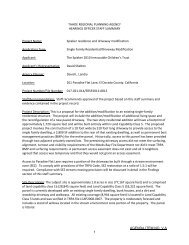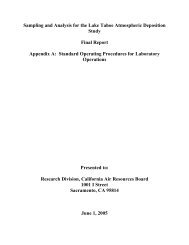FEIS - Tahoe Regional Planning Agency
FEIS - Tahoe Regional Planning Agency
FEIS - Tahoe Regional Planning Agency
You also want an ePaper? Increase the reach of your titles
YUMPU automatically turns print PDFs into web optimized ePapers that Google loves.
RESPONSE TO COMMENTS ON THE DEIS<br />
B o u l d e r B a y C o m m u n i t y E n h a n c e m e n t P r o g r a m P r o j e c t E I S<br />
Comment 3-i: Comment Summary – Hyatt is not comparable to Boulder Bay site. It has more<br />
evacuation routes and is not on the highway.<br />
This is not a comment on the content or adequacy of the DEIS. This information is<br />
passed on to the Project proponent and decision maker(s) for consideration. No<br />
further response to this comment in relation to the DEIS is warranted.<br />
Speaker 4 – John Bosche, Brockway Homeowners Association<br />
Comment 4-a: Comment Summary – Ton of document is written as though prepared by the<br />
applicant. Uses the word “will include” in the project description. Uses similar<br />
language throughout.<br />
Though 'would' is sometimes described as the past tense of 'will', this is not always<br />
the case. Both of these modals are like all other modals, tenseless. The difference<br />
relates to how sure the speaker is or how sure the speaker wants to appear to be.<br />
'Would', a more theoretical modal than 'will' denotes greater uncertainty. A speaker<br />
who is very certain might use 'would' so that they don't appear to be too much of a<br />
know-it-all or it could simply reflect that they are truly less certain. The Boulder Bay<br />
EIS advocates the use of “will” for the impact discussions because determination of<br />
impacts must be made with as little uncertainty as possible. Compliance measures,<br />
standard practices, and recommended mitigation measures “shall” be identified to<br />
clearly avoid, reduce, and mitigate potential impacts. If there is an element of<br />
uncertainty then we use “could.”<br />
Comment 4-b: Comment Summary – Water quality analysis – DEIS says project will capture 100%<br />
of flow – does not believe the conclusions.<br />
Please see Master Response 1 and Appendix AB of the <strong>FEIS</strong>.<br />
Comment 4-c: Comment Summary – No evaluation of the costs of a green roof and how it will be<br />
maintained. Will pervious pavers be vacuumed over the life of the project? Requires<br />
long-term maintenance to ensure success of the project. Agencies may have to fund<br />
all of the proposed measures to maintain the proposed stormwater systems.<br />
Please see responses to comments 137-g (green roofs), 137-e, 335-j, 335-p, 335-ae<br />
and 337-e (pervious pavers). Chapter 6 details standard practice SP-10, Inspection,<br />
Maintenance and Monitoring Plan. Boulder Bay, LLC will be held accountable for<br />
maintaining onsite stormwater treatment systems. Boulder Bay and Placer County are<br />
negotiating long-term funding commitments for offsite stormwater treatment<br />
systems.<br />
Comment 4-d: Comment Summary – Existing culvert under SR 28 is undersized now and won’t<br />
allow for project flows.<br />
Please see response to comment 337-d.<br />
Comment 4-e: Comment Summary – Traffic – DEIS does not study costs of the transportation<br />
program and what would happen if Boulder Bay does not fund the programs.<br />
Speaker 5 – Paul Reynolds<br />
The transportation program and associated mitigation measures are part of the Project<br />
and are required to be funded by Boulder Bay, LLC.<br />
Comment 5-a: Comment Summary – Neighbor in favor of the project. Thinks the project will<br />
improve the area.<br />
PAGE 8- 170 HAUGE BRUECK ASSOCIATES SEPTEMBER 8 , 2010






